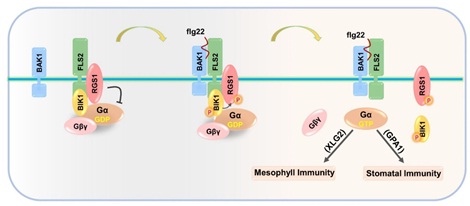Heterotrimeric G proteins are universal signaling modules in eukaryotic organisms. They regulate transmembrane signaling by coupling to cell surface-localized receptors. In animals, heterotrimeric G proteins are activated by seven-transmembrane G protein-coupled receptors (GPCRs). Unlike animals, no functional GPCR proteins are identified in plants and plant heterotrimeric G proteins are reported to directly couple to single transmembrane receptor kinases (RKs) or receptor-like proteins (RLPs). Furthermore, plant Ga proteins are self-activating and can bind GTP in the absence of GPCRs. How plant receptor kinases regulate heterotrimeric G proteins remains unknown.
A team led by ZHOU Jian-Min at Institute of Genetics and Development Biology of Chinese Academy of Sciences discovered how plant receptors regulate the activation of heterotrimeric G proteins.
Arabidopsis immune receptor kinase FLS2 perceives bacterial flagellin and triggers downstream immune signaling through the central kinase BIK1. The researchers previously found that heterotrimeric G proteins directly coupled to the FLS2-BIK1 immune complex and positively regulate BIK1 stability in the resting state. This is distinct form animal G proteins, which regulate immune signaling only after ligand perception.
In the current study, they show that G protein activation is directly controlled by RGS1, a GTPase accelerating protein (GAP), which maintains Ga protein in a GDP-bound form by it GAP activity. Further study showed that RGS1 is directly coupled to FLS2 receptor and Ga proteins. After flg22 perception, BIK1 and its related PBL kinases directly phosphorylate RGS1 Ser428 and Ser431, which riggers the dissociation of RGS1 from the FLS2-G protein complex. This relieves G proteins from the RGS1-mediated repression and enables positive regulation of immune signaling.
In the animal model, GPCRs act as guanine nucleotide exchange factors (GEFs) to promote GDP-GTP exchange in Ga to activate the G proteins. Unlike animals, plant receptor kinases do not possess GEF activity and plant Ga protein can spontaneously bind GTP without GEFs. For a long time, how single transmembrane plant receptors activate heterotrimeric G protein remains unknow.
This study revealed that ligand-induced de-repression as a mechanism for G protein signaling that is distinct from animal heterotrimeric G proteins.
The findings are published online in Cell Research entitled “Ligand-triggered de-repression of Arabidopsis heterotrimeric G proteins coupled to immune receptor kinases” on March 15, 2018. Dr. LIANG Xiangxiu and MA Miaomiao are the co-first authors of the paper.
This work was supported by National Natural Science Foundation of China, Ministry of Science and Technology of the People's Republic of China, the Strategic Priority Research Program of the Chinese Academy of Sciences, and the State Key Laboratory of Plant Genomics.
Figure 1. Model for RGS1-Gαbγ regulation by FLS2 (Image by IGDB)
Contact:
Prof. ZHOU Jian-Min
Institute of Genetics and Developmental Biology, Chinese Academy of Sciences, Beijing China
 Figure 1. Model for RGS1-Gαbγ regulation by FLS2 (Image by IGDB)Contact:Prof. ZHOU Jian-MinInstitute of Genetics and Developmental Biology, Chinese Academy of Sciences, Beijing ChinaEmail: jmzhou@genetics.ac.cn
Figure 1. Model for RGS1-Gαbγ regulation by FLS2 (Image by IGDB)Contact:Prof. ZHOU Jian-MinInstitute of Genetics and Developmental Biology, Chinese Academy of Sciences, Beijing ChinaEmail: jmzhou@genetics.ac.cn CAS
CAS
 中文
中文




.png)
